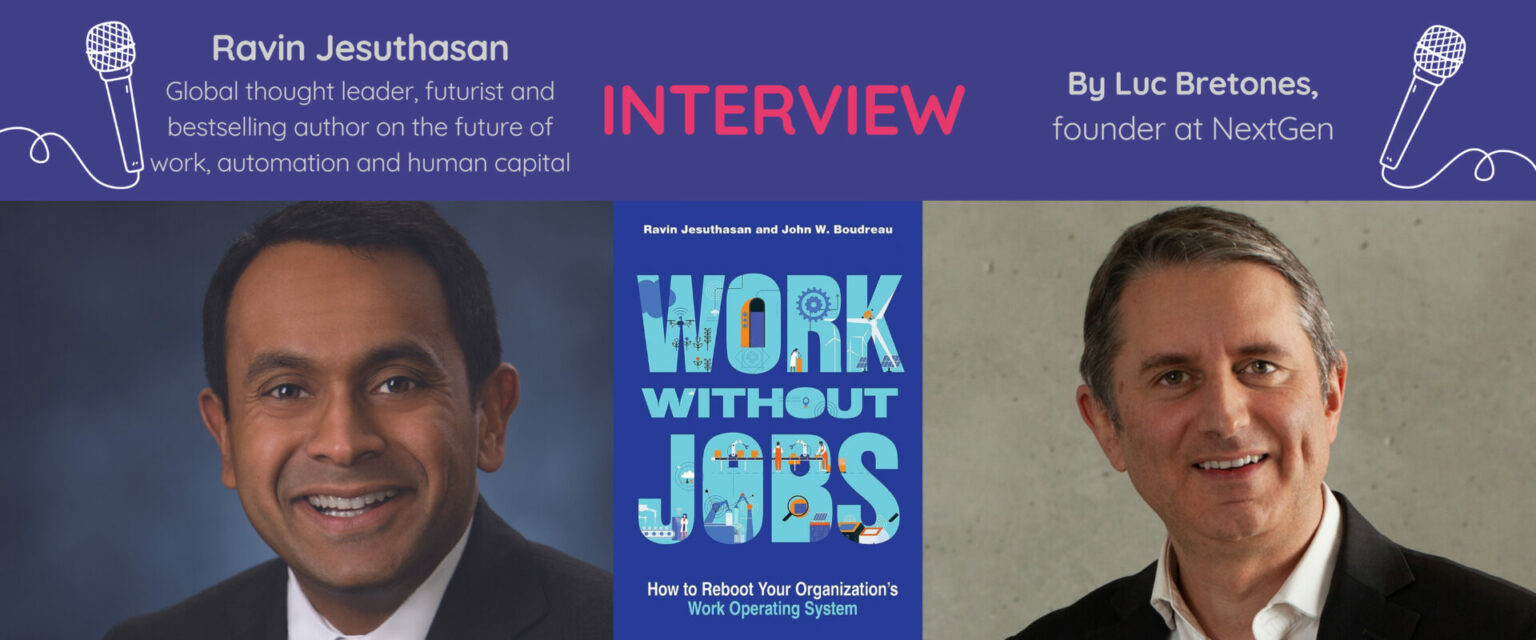
"Managers and HR are in the ideal position to deconstruct jobs, redeploy work to new options and reconstruct new and more impactful ways of working"
Ravin jesuthasan
Ravin Jesuthasan is a global thought leader, futurist and bestselling author on the future of work, automation and human capital
We already have many small organizations operating in this way. They are made up networks of talent that come together to solve various challenges. In Lead the Work: Navigating a World Beyond Employment (Wiley, 2015), John Boudreau, David Creelman and I shared frameworks and numerous examples of organizations operating in this way. Precarious is a phrase that is subject to interpretation and while there are certainly examples of exploitive relationships, there are also examples of significant value for the individual. To be clear, employment still is and will continue to represent the primary way in which work is done but that is changing.
NextGen team red “Lead the Work” and catched the following key points and examples:
Traditional models of full-time employment are becoming obsolete as new forms of work arrangements emerge, such as freelance work, contract work, “boomerang” employees who return after gaining experience elsewhere, and various talent-sharing models between organizations. Leaders are urged to adapt and focus on “leading the work,” regardless of who performs it or where it takes place.
For instance, Ion Torrent used a freelance talent platform, Topcoder, to solve a complex data issue more efficiently than with in-house staff. A large European energy company employs over 100,000 contractors for flexibility and cost-effectiveness, albeit with challenges in long-term commitment and knowledge retention. In academia, a crowdsourced game called Foldit helped tackle the complex problem of protein folding without monetary compensation.
If you look at the share of employment by large companies in most developed markets, that number is a small and declining one. As more companies become platform-based organizations, there will be increased divergence between revenues and headcount.
NextGen team key take aways coming from “Lead the Work”:
Strong trends are emerging where even full-time employees are embracing a free agent mindset and juggling multiple roles, enabled by increasingly flexible work arrangements.
In that context, people increasingly view themselves as “CEOs of Me”, emphasising personal agency and job fluidity.
The book introduces the concept of “PICF” which stands for Permeable, Interlinked, Collaborative, and Flexible organizations. These organizations outsource, collaborate, and form alliances based on strategic considerations to fulfill their needs in the most efficient manner. No function is so core to an organization that it can’t be outsourced or shifted, suggesting that adaptability is key to sustainable performance. The complexities of decision-making in choosing what to keep in-house and what to outsource or collaborate on, positing that these decisions should be guided by where the most value can be generated.
I think traditional jobs with their traditional one-to one relationship with a jobholder will increasingly be questioned and challenged but I see new ways of working within the construct of employment; please see the fixed, flex and flow models that John Boudreau and I describe in our book “Work Without Jobs” (MIT Press, 2022).
NextGen team red “Work without Jobs” and catched the following key points and examples:
In comparison to the conventional work operating system which begins with job roles, the new system focuses on tasks that need to be done. Traditional systems might question the implications of automation on current jobs, whereas this innovative approach asks what tasks exist (or will exist), who can perform them, and how best to engage talent, whether through full-time employment or alternative arrangements.
Here are the main principles of the new work operating system:
I think these models are critical to enabling the agile, more human operating model that we require. However, the goals and intent of most of these framework are often compromised by the traditional job and jobholder model. That is why we advocate for a new work operating system based on the elemental tasks and underlying skills and capabilities in Work Without Jobs.
NextGen team key take aways coming from “Work without Jobs”:
Companies could enhance its agility by breaking jobs into tasks. This change fosters collaboration and smooth task execution. Organizations must introspect their existing work structures, pinpointing areas demanding agility. Critical assessment areas include outdated job descriptions or situations where candidates lean towards non-traditional work setups.
However, the shift to this new approach won’t be uniform across all sectors of an organization. Some roles may remain aligned with the traditional system. Nevertheless, as time progresses, an increasing number of areas will benefit from these unconventional work engagement methods.
Managers and HR are in the ideal position to deconstruct jobs, redeploy work to new options and reconstruct new and more impactful ways of working.
Here are the key elements of the link shared by Ravin :
These technological advancements empower organizations to meticulously deconstruct jobs, pinpointing specific tasks and assessing which are ripe for automation or a shift to alternative talent. This process requires a deep dive into the economic and performance ramifications of each decision. Subsequently, organizations must ascertain the best-fit form of automation or talent and innovate by crafting novel job architectures and streamlined workflows.
Automation presents in diverse types, notably Robotic Process Automation, Cognitive Automation, and Social Robotics. The challenge is to discern how automation will serve: will it augment, transform, or replace human functions?
To align talent with work, several avenues are available, including centralization, outsourcing, contractor or gig-based roles, full-time positions, internal talent bazaars, and positions for lower-level full-time staff.
The ultimate impact of these strategic shifts is multifaceted: a spike in agility and efficiency, fostering an environment of growth and swift decision-making, shedding light on future skill requirements and reskilling avenues, unearthing avenues for task automation, and ushering in a more flexible talent framework as opposed to rigid roles.
Absolutely. We need to humanize work. Deconstruction lets companies see the whole person and the unique bundle of skills and attributes that is Luc versus Ravin. It enables us to escape the traditional, highly limiting headlines that accompany a job and the person occupying it.
We have given leaders a playbook for achieving the optimal combinations of humans and automation in our last two books; Reinventing Jobs: A Four Step Approach for Applying Automation to Work (HBR Press, 2018) and Work Without Jobs: How to Reset Your Work Operating Model (MIT Press, 2022).
NextGen team key take aways coming from “Work without Jobs”:
The book underscores a pressing need for a shift in the traditional work model. While certain jobs still fit within the conventional framework, the evolving nature of work demands a more agile approach, integrating automation and diverse work arrangements. Adopting this new operating system provides a strategic advantage for businesses to remain competitive in a changing landscape. The speed and dynamism of modern work outpace traditional job structures.
Though not all jobs will immediately fit this new paradigm, the trend is undeniably moving towards more flexible, non-traditional work structures.
Organizations must adapt to this new work operating system, particularly in domains requiring agility. Adopting such a system will future-proof businesses as the work landscape continues its pivot towards a “work without jobs” model.
We need a mindset of perpetual reinvention to frame all our choices as a society and we need learning to be designed into the flow of work. Progressive companies know that upskilling and reskilling need to be the epicenter of the talent value proposition.

An interview by Luc Bretones, Founder at NextGen
| Cookie | Duration | Description |
|---|---|---|
| cookielawinfo-checkbox-analytics | 11 months | This cookie is set by GDPR Cookie Consent plugin. The cookie is used to store the user consent for the cookies in the category "Analytics". |
| cookielawinfo-checkbox-functional | 11 months | The cookie is set by GDPR cookie consent to record the user consent for the cookies in the category "Functional". |
| cookielawinfo-checkbox-necessary | 11 months | This cookie is set by GDPR Cookie Consent plugin. The cookies is used to store the user consent for the cookies in the category "Necessary". |
| cookielawinfo-checkbox-others | 11 months | This cookie is set by GDPR Cookie Consent plugin. The cookie is used to store the user consent for the cookies in the category "Other. |
| cookielawinfo-checkbox-performance | 11 months | This cookie is set by GDPR Cookie Consent plugin. The cookie is used to store the user consent for the cookies in the category "Performance". |
| viewed_cookie_policy | 11 months | The cookie is set by the GDPR Cookie Consent plugin and is used to store whether or not user has consented to the use of cookies. It does not store any personal data. |